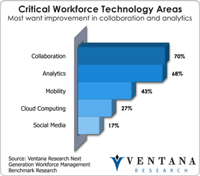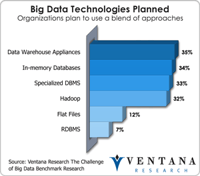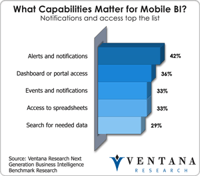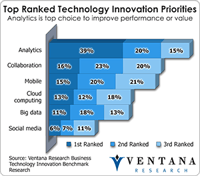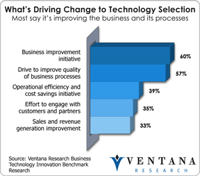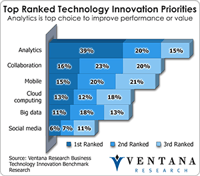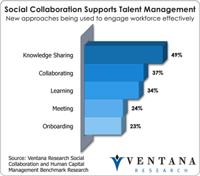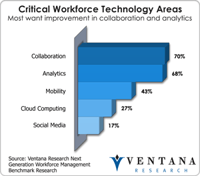Since the early ’80s, when I personally experienced the transition from written time cards to cards for swiping on a time clock at a grocery retailer I worked at, I have been interested in the software and technology of workforce management. That gives me a perspective not many analysts can match when it comes to transitioning to new technology to help organizations manage and engage workforces. Ventana Research recently completed benchmark research on next-generation workforce management,...
Read More
Topics:
Mobile Technology,
Social Collaboration,
Operational Performance,
Business Performance,
Workforce Performance,
Workforce Analytics,
Workforce Management
I recently started a series of blog posts on what CEOs (and for that matter, all senior corporate executives) need to know about IT. The first covered the high-level issues. As I noted there, it’s not necessary for a CEO of a company to be able to write Java code or master the intricacies of an ERP or sales compensation application. However, CEOs must grasp the basics of IT just as they must understand basic corporate finance, the production process and – at least at a high level – the...
Read More
Topics:
Big Data,
Mobile,
SaaS,
Sales Performance,
Social Media,
Supply Chain Performance,
Customer,
ERP,
Operational Performance,
Business Analytics,
Business Collaboration,
Business Performance,
Cloud Computing,
Complex Event Processing,
Customer & Contact Center,
Financial Performance,
In-memory,
Information Management,
Workforce Performance,
CFO,
CEO,
PaaS
Over the last few weeks SAP has run several events for both customers and the analyst community to herald the launch of SAP 360 Customer in an attempt to regain ground in the CRM market and convince everyone that it has sorted out its cloud, mobile and collaboration strategy. One of the main user events was Sapphire NOW in Madrid earlier this month. From reports that I have seen, it seems that customers at that conference were far from convinced – and if customers are not convinced then...
Read More
Topics:
Sales Performance,
Salesforce.com,
SAP,
Social Media,
Customer Analytics,
Customer Experience,
Social CRM,
Voice of the Customer,
Mobile Apps,
Analytics,
Business Collaboration,
Cloud Computing,
Collaboration,
Customer & Contact Center,
Customer Service,
CRM
I’ve been examining how corporations plan and budget for more than decade. One clear pattern that has emerged is the difficulty that using desktop spreadsheets imposes on the process. Ventana Research recently published findings from our trends in business planning benchmark research, and the research once again confirms this observation. It shows that companies that use dedicated applications are consistently more satisfied (and much less dissatisfied) with the software they use than users of...
Read More
Topics:
Big Data,
Planning,
Sales Performance,
Supply Chain Performance,
Office of Finance,
Reporting,
Budgeting,
driver-based,
Operational Performance,
Business Performance,
Customer & Contact Center,
Financial Performance,
Workforce Performance,
Financial Performance Management,
Integrated Business Planning
The parent company of mplSystems, Message Pad Ltd., was founded in the U.K. in 1994 and provides the infrastructure to support contact center operations. mplSystems’ main product family is intelligentContact (iContact), which is available either on premises or in the cloud. It is an interesting mix of products that covers call, email, chat, SMS, social media management and routing from a universal queue, a new social media product that routes social media posts to agents and provides the...
Read More
Topics:
Microsoft,
Social Media,
Customer Analytics,
Customer Experience,
Social CRM,
Speech Analytics,
Voice of the Customer,
Mobile Apps,
Analytics,
Cloud Computing,
Collaboration,
Customer & Contact Center,
Customer Service,
Call Center,
Contact Center,
Contact Center Analytics,
CRM,
Desktop Analytics,
Text Analytics,
Unified Communications
Many people enjoy mystery stories or crime thrillers; in the same vein of savoring the whodunnit and howdunnit, I like a good accounting scandal. My fascination with cooking the books started when I was young with the “great salad oil swindle”, which wound up causing losses in excess of $1 billion in today’s money and even threatened a Wall Street collapse. This disaster was averted by the assassination of President Kennedy, which kept markets closed on Monday, November 25, 1963, and gave the...
Read More
Topics:
Fraud,
Governance,
GRC,
Office of Finance,
audit,
IFRS,
Business Performance,
Financial Performance,
Governance, Risk & Compliance (GRC),
Hewlett Packard,
Meg Whitman,
SEC
The technology ecosystems are expanding rapidly and the use of big data and cloud computing challenge organizations to process information efficiently and deliver consistent high-quality data. To address these issues, Informatica has introduced two new offerings.
Read More
Topics:
Big Data,
Social Media,
Operational Performance,
Business Analytics,
Business Performance,
Cloud Computing,
Data Integration,
Informatica,
Information Applications,
Information Management,
Strata+Hadoop
Tableau Software is growing fast. Tableau has taken a “land and expand” strategy that drives what they call the democratization of analytics within organizations. Tableau has enjoyed first mover advantage in the area of exploratory analytics called visual discovery, a growing type of business analytics that allows companies to easily visualize data in a descriptive manner, but the company is facing competition as deep-pocket companies such as IBM, SAP and others become more aggressive in the...
Read More
Topics:
Big Data,
Data Visualization,
Sales Performance,
Tableau,
Google,
discovery analytics,
exploratory analytics,
Operational Performance,
Analytics,
Business Analytics,
Business Collaboration,
Business Intelligence,
Business Performance,
Customer & Contact Center,
Operational Intelligence,
Impala,
big query
Business analytics has become the highest ranked technology innovation, according to our benchmark research on business technology innovation, but a lack of trained resources and inefficient technology have hampered the best of organizations when they attempt to roll out analytics. Our benchmark research on business analytics in 2012 found that the majority of analysts in organizations spend more of their time on data-related activities than on analytic tasks, and our 2013 research on business...
Read More
Topics:
Big Data,
Sales Performance,
Social Media,
Supply Chain Performance,
Narrative Science,
Operational Performance,
Business Analytics,
Business Collaboration,
Business Intelligence,
Business Performance,
CIO,
Cloud Computing,
Customer & Contact Center,
Financial Performance,
Information Applications,
Information Management,
Workforce Performance,
Expert Systems,
Digital Technology
Read More
Topics:
Social Media,
Customer Analytics,
Customer Experience,
Customer Feedback Management,
Social CRM,
Speech Analytics,
Voice of the Customer,
Mobile Apps,
Operational Performance,
Analytics,
Cloud Computing,
Collaboration,
Customer & Contact Center,
Customer Service,
Call Center,
Contact Center,
Contact Center Analytics,
CRM,
Desktop Analytics,
Text Analytics,
Unified Communications,
Vendor(s),
Workforce Force Optimization
Read More
Topics:
Sales Performance,
Social Media,
Supply Chain Performance,
IT Performance,
Operational Performance,
Business Intelligence,
Business Performance,
CIO,
Customer & Contact Center,
Financial Performance,
Information Applications,
Information Management,
Location Intelligence,
Operational Intelligence,
Twitter,
Workforce Performance,
CMO,
COO,
Industry Analyst,
Technology Vendors
Read More
Topics:
Sales Performance,
SAP,
Social Media,
Supply Chain Performance,
Peoplefluent,
Planview,
Research,
Splunk,
IT Performance,
Operational Performance,
Business Analytics,
Business Collaboration,
Business Intelligence,
Business Performance,
CIO,
Cloud Computing,
Customer & Contact Center,
Financial Performance,
IBM,
Information Applications,
Information Management,
Location Intelligence,
Operational Intelligence,
Workforce Performance,
Ceridian,
CFO,
CMO,
COO,
Datawatch,
Saba,
Technology
I have challenged some of the hype about the social enterprise because I feel “social” gives the wrong impression. For most people, social media is predominately about being social. While everyone likes to feel that going to work is partly about being social, when it comes down to it running a business is about winning customers, selling them your products or services, and providing customer service when needed. In today’s competitive markets, none of these is an easy task.
Read More
Topics:
Social Media,
Customer Analytics,
Customer Experience,
Customer Feedback Management,
Social CRM,
Speech Analytics,
Voice of the Customer,
Mobile Apps,
Operational Performance,
Analytics,
Business Collaboration,
Cloud Computing,
Collaboration,
Customer & Contact Center,
Customer Service,
Call Center,
Contact Center,
Contact Center Analytics,
CRM,
Desktop Analytics,
Text Analytics,
Unified Communications,
Vendor(s),
Workforce Force Optimization
The business/IT divide is a barrier that prevents most companies from achieving their true performance potential. The divide has remained a constant impediment since the dawn of business computing six decades ago. It’s not necessary for a CEO of a company to be able to write Java code or master the intricacies of an ERP or sales compensation application. However, that CEO must master the basics of IT just as he must understand basic corporate finance, the production process and – at least at a...
Read More
Topics:
Big Data,
Performance Management,
Sales Performance,
Supply Chain Performance,
Human Capital Management,
competition,
executive,
Operational Performance,
Business Performance,
CIO,
Cloud Computing,
Customer & Contact Center,
Financial Performance,
In-memory,
Workforce Performance,
CFO,
IT,
CEO,
FPM
Mobile technology continues to advance weekly, with new software releases and new versions of devices. Though it has been in the headlines frequently in recent weeks, can Microsoft really change the mobile technology dynamics in the business world?
Read More
Topics:
Microsoft,
Sales Performance,
Google,
Microsoft Windows Phone,
IT Performance,
Operational Performance,
Business Intelligence,
Business Performance,
Cloud Computing,
Customer & Contact Center,
Financial Performance,
Information Applications,
Information Management,
Workforce Performance,
Digital Technology
People have been complaining about the budgeting and planning processes in their organizations for decades. If you’re old enough, you may recall President Carter’s failed attempt to use something called zero-based budgeting to impose discipline in federal outlays. (In his first year in office the federal government reported a whopping $54 billion deficit.) Some complaining is almost inevitable, but some reflects the one-way nature of the process. People spend time on creating a budget and don’t...
Read More
Topics:
Big Data,
Planning,
Sales Performance,
Supply Chain Performance,
Office of Finance,
Reporting,
Budgeting,
driver-based,
Operational Performance,
Business Performance,
Customer & Contact Center,
Financial Performance,
Workforce Performance,
Financial Performance Management,
Integrated Business Planning
Read More
Topics:
Customer Analytics,
Customer Experience,
Speech Analytics,
Voice of the Customer,
Callminer,
Analytics,
Business Analytics,
Customer & Contact Center,
Customer Service,
Call Center,
Contact Center,
Contact Center Analytics,
CRM,
Desktop Analytics,
Text Analytics
TribeHR has brought to market an HR application suite that uses social collaboration to empower workers and managers to perform tasks that might once have been done mostly by HR professionals, or not done at all. The software-as-a-service-based TribeHR application helps businesses with fewer than 500 employees with recruiting, applicant tracking, onboarding, performance and goal setting, and time and vacation management – but with a twist. By using social collaboration as a foundation for its...
Read More
Topics:
Performance Management,
Human Capital Management,
Recruiting,
Social Collaboration,
Operational Performance,
Business Collaboration,
Business Performance,
Cloud Computing,
Workforce Performance,
Hiring,
HR,
TribeHR
Workforce management software vendor Kronos released its financial results at its 15th annual KronosWorks conference (#KronosWorks12) this week. As a private company Kronos had $870 million in revenue for its 2012 fiscal year ending in September, making Kronos one of the largest software and technology companies in the world. Our benchmark research into next-generation workforce management finds the most important technology priorities are collaboration (70%), analytics (68%) and mobility...
Read More
Topics:
Mobile Technology,
Business Analytics,
Business Collaboration,
Cloud Computing,
Information Applications,
Tablets,
Workforce Analytics,
Workforce Management
Vocalcom is one of the up-and-coming names in the contact center market. Founded in 1995, it is headquartered in France but has a worldwide presence, with 4,500 customers and more than half a million users of its services. It may not be as well-known as other companies in the same space because many of the customers are in southern Europe, and a high percentage are outsourcers who use its services to provide contact center services based on its platform. It offers what I call multichannel...
Read More
Topics:
Salesforce.com,
Social Media,
Customer Analytics,
Customer Experience,
Social CRM,
Speech Analytics,
Voice of the Customer,
Mobile Apps,
Analytics,
Cloud Computing,
Collaboration,
Customer & Contact Center,
Customer Service,
Call Center,
Contact Center,
Contact Center Analytics,
CRM,
Desktop Analytics,
Text Analytics,
Unified Communications,
Vocalcom
Organizations engage in a range of forward-looking activities. Sales organizations have pipelines to forecast sales. Manufacturing organizations set and reset demand plans and near-term production schedules, often in response to longer-term production plans that determine what they will make and where and how they will make it. Logistics people plan inbound and outbound shipments. Marketing departments plan advertising and promotion campaigns. HR departments project staffing requirements and...
Read More
Topics:
Big Data,
Planning,
Sales Performance,
Supply Chain Performance,
Office of Finance,
Reporting,
Budgeting,
driver-based,
Operational Performance,
Business Performance,
Customer & Contact Center,
Financial Performance,
Workforce Performance,
Financial Performance Management,
Integrated Business Planning
